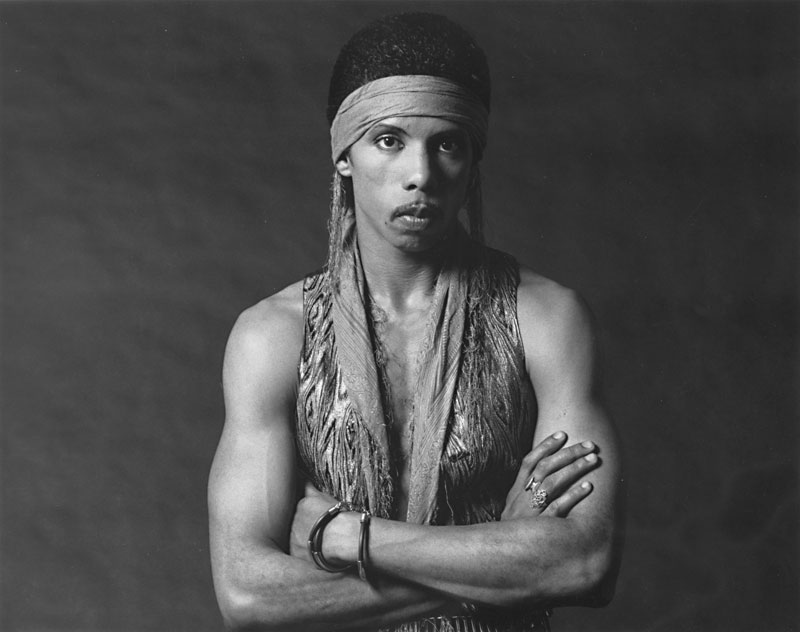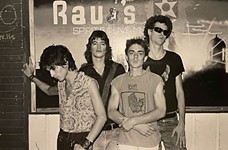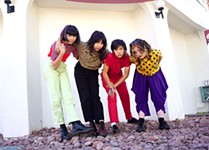The Glam Punks of 70s Austin Get Up to Their Gypsy Tricks
The Austin Punk Chronicles, chapter two, part two: Glitter rock (1972-76) fades
By Tim Stegall, Fri., Jan. 24, 2020
Grown men playing with adult weapons and sophistication galvanized Franklin's Mast's young black singer/drummer Bevis Griffin.
Born in Los Angeles, 1953, he'd witnessed R&B become rock & roll at age 5 as genre giants like Ike Turner and Bobby "Blue" Bland frequented his father's barbershop next door to the 5-4 Ballroom, a prime venue on the Chitlin' Circuit. Entering teenhood as the Beatles and Stones upended the musical universe, he observed South Central denizens groovin' to "Day Tripper," and Arthur Lee and Johnny Echols grabbing a piece of the action in Love. Then he got sent to Wichita Falls to keep out of trouble.
It found him nonetheless.
Griffin's antics, like taking his shirt off in class to beat the heat, caught the attention of budding guitarist Jimmy Lee Saurage, a half-Korean result of a wartime union, adopted by a self-described "Arkansas hillbilly" Air Force family. After high school, the two played James Gang and Grand Funk Railroad numbers at area service clubs and teen canteens as Franklin's Mast with bassist Barry Minnick. The name derived from a pair of store names spliced together by Saurage "because it sounded like Led Zeppelin."
Among the bands they encountered on this circuit, Krackerjack prompted Griffin in November 1971 to follow them to Austin, where Saurage met up with him the next year to reform Franklin's Mast with bassist Jimmy Fleming.
"Barry left due to social anxiety caused by our wild, lewd, and lascivious lifestyle," guffaws Griffin.
At this point, the bandleader aimed the group in a new direction.
"Bevis listened to a lot of black music," Saurage recalls, "but he wanted to be a glam rock star. He was way into David Bowie, the New York Dolls, all that. He was way more sophisticated than me in music and fashion."
"My glam style was inspired by Hendrix, Sly Stone, Small Faces, T. Rex, Bowie, Slade," muses Griffin now. "I loved Alice Cooper. He really got under people's skins. Iggy [Pop] was the most nihilistic thing you could put on the cover of a magazine. I'm absorbing and assimilating all this, and I'm doing it as a drummer that sings.
"But I was frustrated, because I could never find front guys. Even Jimmy Saurage, as extroverted as he was, I constantly had my foot up his ass: 'Ya gotta do more! Slit your wrists – something! We need to explode some shit!'"
Franklin's Mast already cut a profile. Even in glam, where outré was in, mixed-race combos were rare. Meanwhile, Griffin strutted around Austin in an Afro that would've given the Ohio Players' Sugarfoot Bonner pause.
"Those days were mad dangerous," he laughs. "I would get accosted on the street. I had to carry nunchucks! I had a man bag full of weapons! And I was asking for it. A Clockwork Orange was a huge influence on my young mind, and I literally became a droog."
Life on Mars
Any Texas glitter critter took their life in their hands. Social mores about sexuality, fashion, and gender roles found their match in rock & roll. A state of cow town origins didn't take this peaceably.
"Good way to get beat up," laughs first-generation ATX punk Eddie Munoz. "These closeted cowboys didn't know whether to fight you or fuck you."
"Franklin's Mast were booked by the Hatchett Booking Agency, who handled all the Texas glam acts and cover bands," recalls Saurage. "We would get booked into Midland, Odessa, Killeen, Abilene – real redneck places. We'd show up dressed in pink pants and some kinda beige satin shirt tied in front like a girl. We would attract all these girls who thought we were on the cutting edge.
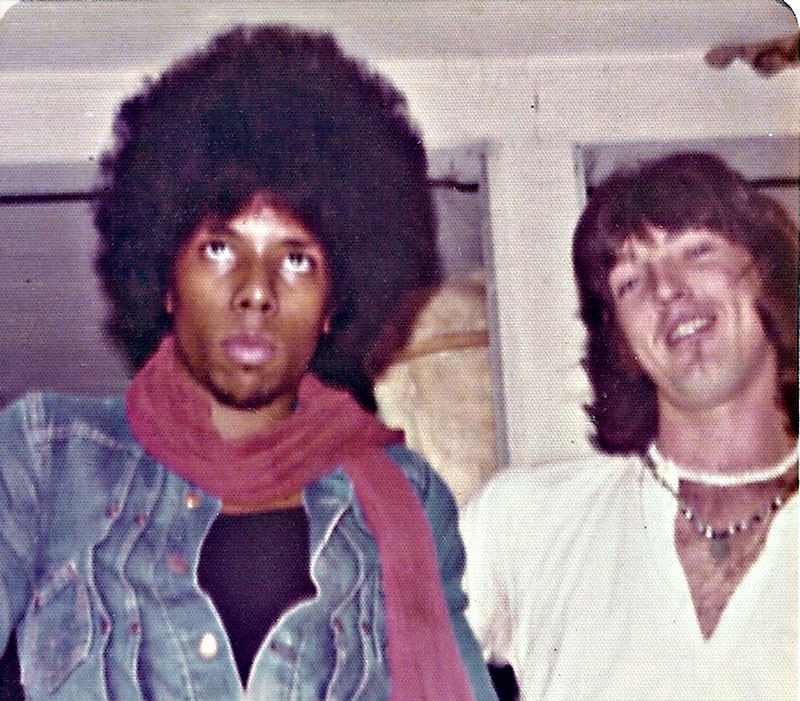
"But we had our detractors – rednecks, girls and guys too – who would form opposing camps in the audience.
"I remember in Odessa," he laughs. "This kid came up to us at the break and said, 'Hey, there's gonna be a rumble after y'all's show! The guys that hate you are gonna try to attack you as you leave the club. But don't worry, I've got my chainsaw underneath your van!'"
Even within the glam community, confusion surfaced. Saurage recalls the Werewolves' Seab Meador – no stranger to gender-bending fashion – eyeballing him at a party and announcing, "Y'know, I wouldn't know what to do with a dick." On another occasion, post-gig, the Franklin's Mast guitarist drove the band's equipment home after swallowing a quaalude someone handed him. Pulled over by the police when he barfed out the car window, he quickly changed seats with a roadie.
"The cop took one look at us and said, 'Y'all are dressed like you're from Mars! That's it, I'm gonna hafta take you into the station. The guys are not gonna believe me unless I show them!'"
"The hippies thought we were from another planet," snorts Krackerjack guitarist Gary Myrick. "We played Mother Earth once and as I walked out, some guy said, 'Let the queers through.' I looked at him and put my guitar case down. I'd had it. I'm not a violent guy, but I slugged him big-time. We had a roadie named Cutter Brandenburg, who ended up working for Stevie Ray [Vaughan] for many years, and he was my super-bro. He pushed me out of the way and beat the fuck outta that guy!
"We were glam punks. We didn't give a fuck. We were ready to throw down with anyone we had to."
Thanks to steady gigs on Charlie Hatchett's statewide network (see "The Hatchett Man," Sept. 30, 2011), Krackerjack lived like rajahs on the mid-Seventies dollar. Their $1,000-per-night guarantees meant they shared a fourplex and enjoyed plenty of leftover scratch for new Les Pauls, Marlboros, fifths of Jim Beam, little baggies of this 'n' that, and spending sprees in thrift store women's departments, according to initial bassist Tommy Shannon.
"We never had money," counters Griffin. "There were places where you could get five hamburgers for $8. As long as it didn't bite back, quality didn't matter. And we were motorheads, so we really didn't eat that much!"
Echoing Shannon, he recounts salvaging runs at thrifts across East and West Texas, as well as on the decaying department stores and notions shops of Sixth Street, where they searched for lace, sequins, and any sort of detail to sew onto antique shirts and repurposed Dickies.
"We used to do some horrendous patchwork that turned out really beautiful," Griffin recounts. "I also had a 20-inch waist for a long time, so I could wear any girl's clothing. First thing you do when you start dating a girl is go through her closet!"
Shapes of Things
In Never the Same Again, Jesse Sublett recalls having to resort to "gypsy tricks" once Jelly Roll commenced.
"We got by on free cover charges, $300 cars, couch crashing, and the kindness of women who loved rock & roll enough to put up with the men who made it," he wrote. "Friendly waitresses lost our tickets or looked the other way when we walked the tab. Being a musician was a life of crime. Every dollar we scammed was better than $10 or $20 in a paycheck from a day job."
Likely Austin's final glam act, Jelly Roll proved the bridge to the city's punk future.
Bassist Sublett escaped Johnson City ennui via Sixties garage-punk and the Stones/Yardbirds R&B that inspired it. Also lured to Austin by Krackerjack, he and girlfriend Dianne Roberts abandoned the few semesters they'd matriculated at Texas State in San Marcos for his rock & roll dreams. Guitarist Munoz blew out of his native San Antonio for Austin in 1973 at 17, armed with his own three-chord dreams and a knack for lacerating riffs. He'd been gigging, first with Silver Clouds, then in Warp Factor 5 with guitarist/girlfriend Carla Olson.
A willowy blonde who Sublett describes in Never the Same Again as a "better-looking, more streetwise Joni Mitchell," Olson still speaks in elasticated Texas vowels despite living in L.A. since 1978. A decade earlier, she and future Blieb Alien autoharpist Billy Miller got together as a teenage recording duo at roughly the time she attended Holy Cross School in her native Austin with Eric Johnson and Jay Podolak.
"I met Jesse at the same time as Eddie," she recalls of a fateful 1976 evening. "We walked into Mother Earth, and there was a guy with a red bandanna wrapped around his head like a pirate. He was sitting at the first table as you walked into the club. Eddie looked at Jesse, Jesse looked at him, and they just immediately bonded.
"The feeling was so mutual between them, they had to start a band. Jelly Roll did Stones and Yardbirds stuff. They didn't write originals. They played the Too Bitter in San Marcos and the Oasis on Ben White and South First. They did three or four 45-minute sets a night, blues rock like everyone else."
Reanimating a dormant outfit formed by singer Danny Coulson, this incarnation of Jelly Roll also featured original lead guitarist Robin Detlefson and drummer Ronn Dixon. Whatever chemistry they shared, however, proved short-lived.
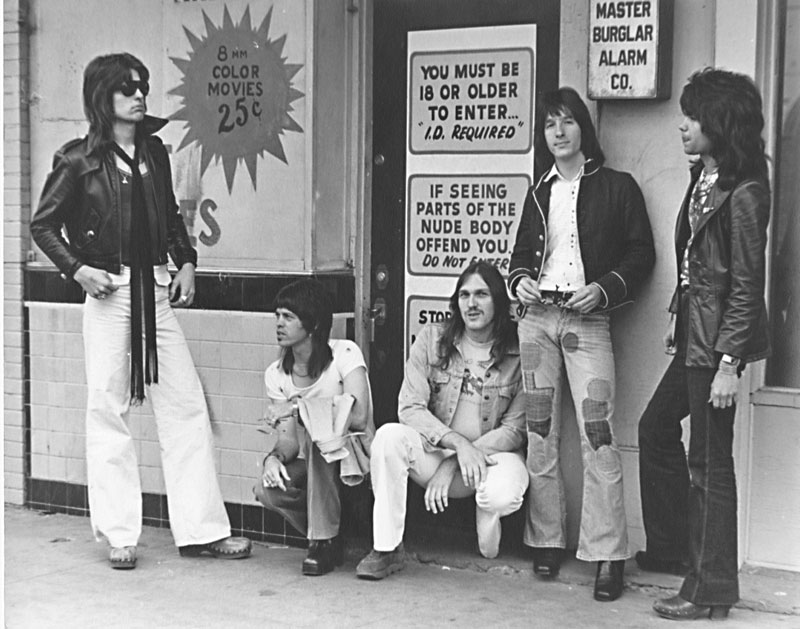
Munoz and Sublett played San Antonio on August 15, 1976, backing a local singer named Queen Bee. While they were gone, a shifty ex-roommate of Roberts and Sublett stopped by with a creepy friend who'd been forbidden from coming to the house, Lyle Richard Brummett. Roberts expressed her dislike of the latter, who returned later that night and let himself in through a window. Sublett discovered Roberts' body the next day when he returned home.
"That was a tough moment for him, obviously," says Olson. "The band still played a few gigs after that, but Jesse needed to stop and take a break."
As went Jelly Roll, so too did Austin/Texas glam escape documentation. Both Myrick, who eventually played in a Krackerjack featuring no original members in its final days, and Shannon claim River City's prime movers never recorded studio demos, although live tapes may exist.
"No one was going to sign us," scoffs Myrick. "You had to live in L.A. or New York to get signed. Major-label talent scouts weren't coming to Austin."
Myrick eventually moved to L.A., achieving New Wave stardom in the early Eighties with minor hit "She Talks in Stereo" and opening for the Kinks in a band with Sex Pistols guitarist Steve Jones before teaming with Clash bassist Paul Simonon in Havana 3am. Shannon famously joined short-lived Krackerjack guitarist Stevie Ray Vaughan's Double Trouble. That left the Werewolves as the sole Texas glam band to reach the brass ring (see "Glitter Rock," Jan. 17).
Unfortunately, by the time Rolling Stones Svengali Andrew Loog Oldham discovered the Dallas combo, lured them to NYC, and inked an RCA deal, his production chops had been decimated by years of debauchery. The Werewolves' two 1978 LPs sounded more like limp Southern boogie than the roaring hard-rock-in-Max-Factor that scared the New York Dolls. Criminally underserved, Meador died of a brain tumor on January 24, 1980.
Holidays in the Sun
Mother Earth's North Lamar location burned down in late 1976. It then moved to East Riverside, in the space that eventually became the Back Room and later redeveloped into the second coming of Emo's. Olson returned from a 1977 England trip seeing her friend Toni Laumer, then involved with Jake Riviera, a colorful London music business character who'd begun a label with his partner Dave Robinson: Stiff Records.
Olson got a unique view of what was brewing across the Atlantic. Returning home, she found Munoz attempting to rouse a still-grieving Sublett. Munoz was boarding with an English woman and her teenage daughter, a guitarist who returned from her own British sojourn with a head full of ideas inspired by witnessing the ruckus raised by the Sex Pistols and other guttersnipes.
"I decided in England," says Kathy Valentine with clear-eyed certainty, "that I would go back to Austin and start the city's first punk band."
This fourth installment of the Austin Punk Chronicles wraps up the second part of a projected 13-chapter serialization spanning last year, this year, and several years to come. The endeavor, here concluding exploration of Austin’s little-documented glam rock scene – correction, “Glitter Rock” scene – resumes in the spring with episode three, “I Wanna See Some History: The Sex Pistols in San Antonio & the Violators at Raul’s.” To recap, visit: www.austinchronicle.com/austin-punk-chronicles.





